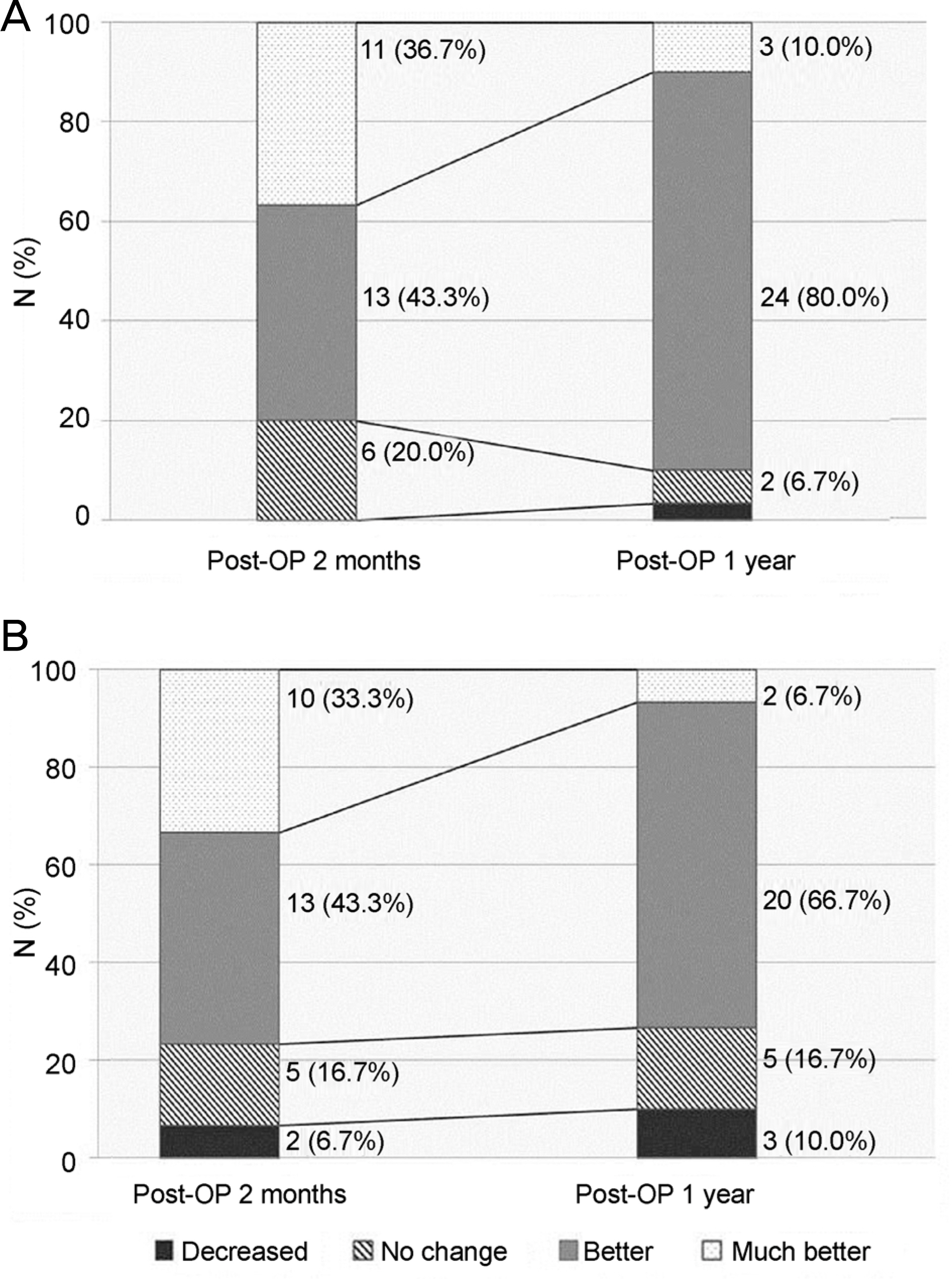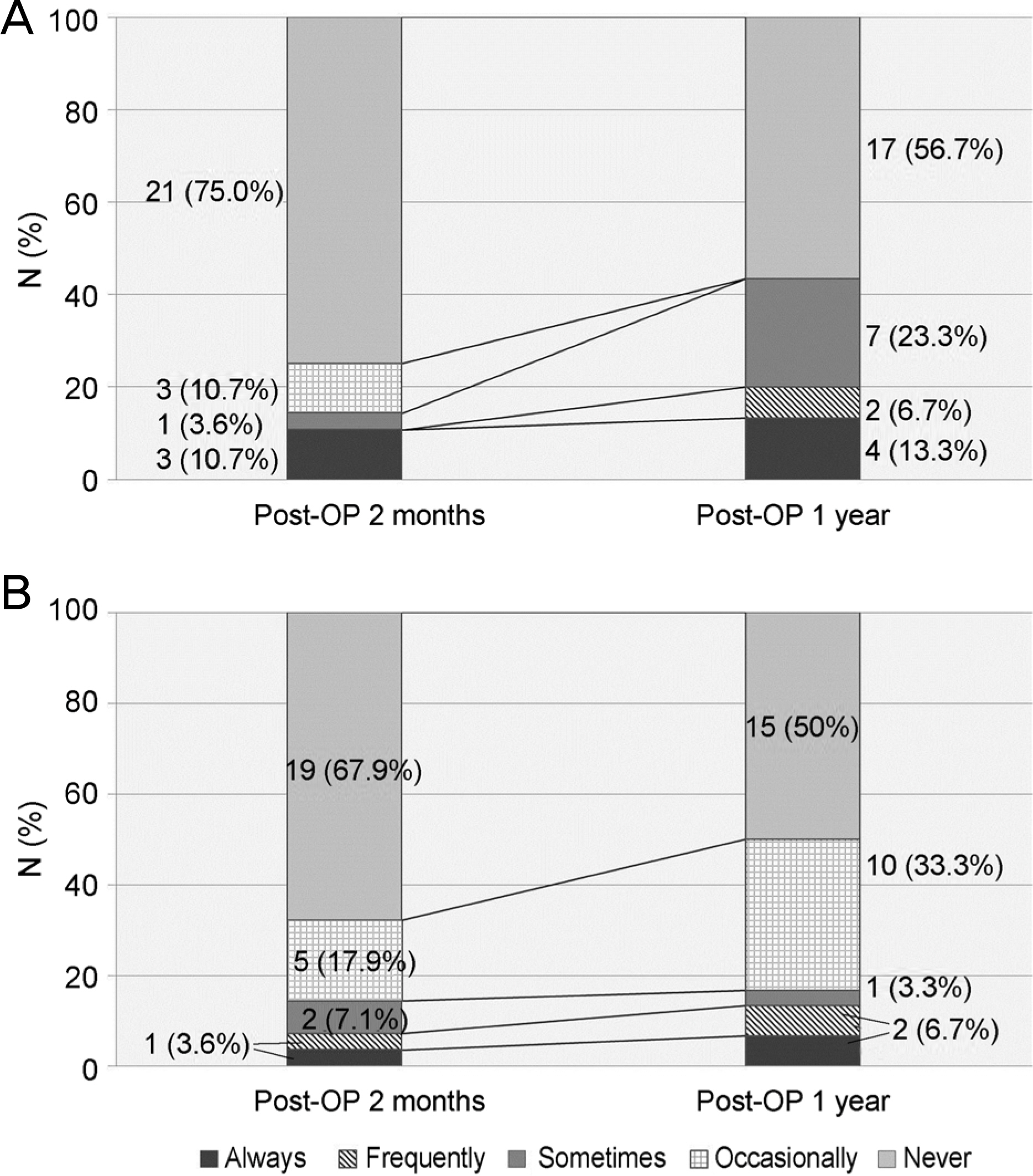J Korean Ophthalmol Soc.
2016 Dec;57(12):1882-1890. 10.3341/jkos.2016.57.12.1882.
Clinical Results of Pseudophakic Monovision 1 Year after Cataract Surgery
- Affiliations
-
- 1Department of Ophthalmology, Konkuk University Medical Center, Konkuk University School of Medicine, Seoul, Korea. 20050129@kuh.ac.kr
- KMID: 2362705
- DOI: http://doi.org/10.3341/jkos.2016.57.12.1882
Abstract
- PURPOSE
In this study, the visual performance and patient satisfaction one year after monovision cataract surgery and the results after 2 months.
METHODS
Thirty patients who had bilateral cataract surgery between February 2010 and January 2014 treated with monovision therapy and received postoperative examinations for at least one year after surgery were enrolled in the present study. The eye with the more severe cataract had the surgery first and was corrected for distance vision targeted at emmetropia. The fellow eye was operated for near vision targeted to -1.50~-2.50 diopter (D) range considering the patient's need for near task and preoperative refractive errors 2-4 weeks after the first operation. Binocular uncorrected distance visual acuity (UCDVA), uncorrected near visual acuity (UCNVA), spherical equivalent, anisometropia, stereopsis, patient satisfaction for far and near distance, and spectacle dependence were evaluated preoperatively and two months and one year postoperatively.
RESULTS
The mean age of patients was 71.9 years. Two months and one year after the surgery, the binocular UCDVA (log MAR) were 0.03 ± 0.10 and 0.08 ± 0.14, UCNVA were 0.21 ± 0.15 and 0.25 ± 0.14, anisometropia were 1.28 ± 0.68 and 1.29 ± 0.76 D, and stereopsis were 301.67 ± 251.28 and 251.67 ± 269.28 arcsec, respectively. One year after the surgery, the number of patients answering "˜Better' or "˜Much better' for distant vision was 27 (90%) and for near vision 22 (73.3%); 11 patients (36.7%) answered "˜Not dependent on spectacles at all'.
CONCLUSIONS
Monovision is an effective method to correct presbyopia after bilateral cataract surgery. Visual performances and patient satisfaction at one year after cataract surgery were not different compared with those at two months.
Keyword
MeSH Terms
Figure
Cited by 1 articles
-
Clinical Study of Changes in Eye Dominance after Pseudophakic Conventional Monovision
Minsub Lee, Ki Cheul Shin
J Korean Ophthalmol Soc. 2019;60(6):534-540. doi: 10.3341/jkos.2019.60.6.534.
Reference
-
References
1. Kim YJ, Cheon MH, Ko DA, et al. Visual function and patient abdominal in pseudophakic monovision. J Korean Ophthalmol Soc. 2012; 53:1621–9.2. Stahl JE. Conductive keratoplasty for presbyopia: 3-year results. J Refract Surg. 2007; 23:905–10.
Article3. Mantry S, Shah S. Surgical management of presbyopia. Cont Lens Anterior Eye. 2004; 27:171–5.
Article4. McDonnell PJ, Lee P, Spritzer K, et al. Associations of presbyopia with vision-targeted health-related quality of life. Arch Ophthalmol. 2003; 121:1577–81.
Article5. Bohórquez V, Alarcon R. abdominal reading performance in abdominals with bilateral dual-optic accommodating intraocular lenses. J Cataract Refract Surg. 2010; 36:1880–6.6. Lane SS, Morris M, Nordan L, et al. Multifocal intraocular lenses. Ophthalmol Clin North Am. 2006; 19:89–105.7. Greenbaum S. Cost-benefit analysis of multifocal IOLs versus monovision pseudophakia. J Cataract Refract Surg. 2009; 35:614.
Article8. Woodward MA, Randleman JB, Stulting RD. Dissatisfaction after multifocal intraocular lens implantation. J Cataract Refract Surg. 2009; 35:992–7.
Article9. Vaquero-Ruano M, Encinas JL, Millan I, et al. AMO array abdominal versus monofocal intraocular lenses: long-term follow-up. J Cataract Refract Surg. 1998; 24:118–23.10. Boerner CF, Thrasher BH. Results of monovision correction in abdominal pseudophakes. J Am Intraocul Implant Soc. 1984; 10:49–50.11. Ito M, Shimizu K, Amano R, Handa T. Assessment of visual performance in pseudophakic monovision. J Cataract Refract Surg. 2009; 35:710–4.
Article12. Finkelman YM, Ng JQ, Barrett GD. Patient satisfaction and visual function after pseudophakic monovision. J Cataract Refract Surg. 2009; 35:998–1002.
Article13. Greenbaum S. Monovision pseudophakia. J Cataract Refract Surg. 2002; 28:1439–43.
Article14. Ito M, Shimizu K, Iida Y, Amano R. Five-year clinical study of abdominals with pseudophakic monovision. J Cataract Refract Surg. 2012; 38:1440–5.15. Zhang F, Sugar A, Jacobsen G, Collins M. Visual function and abdominal satisfaction: comparison between bilateral diffractive abdominal intraocular lenses and monovision pseudophakia. J Cataract Refract Surg. 2011; 37:446–53.16. Hayashi K, Hayashi H. Stereopsis in bilaterally pseudophakic patients. J Cataract Refract Surg. 2004; 30:1466–70.
Article17. Brown B, Yap MK, Fan WC. Decrease in stereoacuity in the sev-enth decade of life. Ophthalmic Physiol Opt. 1993; 13:138–42.
Article18. Lee HY, Her J. Clinical evaluation of monovision after cataract surgery. J Korean Ophthalmol Soc. 2008; 49:1437–42.
Article19. Labiris G, Giarmoukakis A, Patsiamanidi M, et al. Mini-mono-vision versus multifocal intraocular lens implantation. J Cataract Refract Surg. 2015; 41:53–7.
Article20. Arthur B. Factors influencing success and failure in monovision. Int Contact Lens Clin. 1995; 22:165–72.




